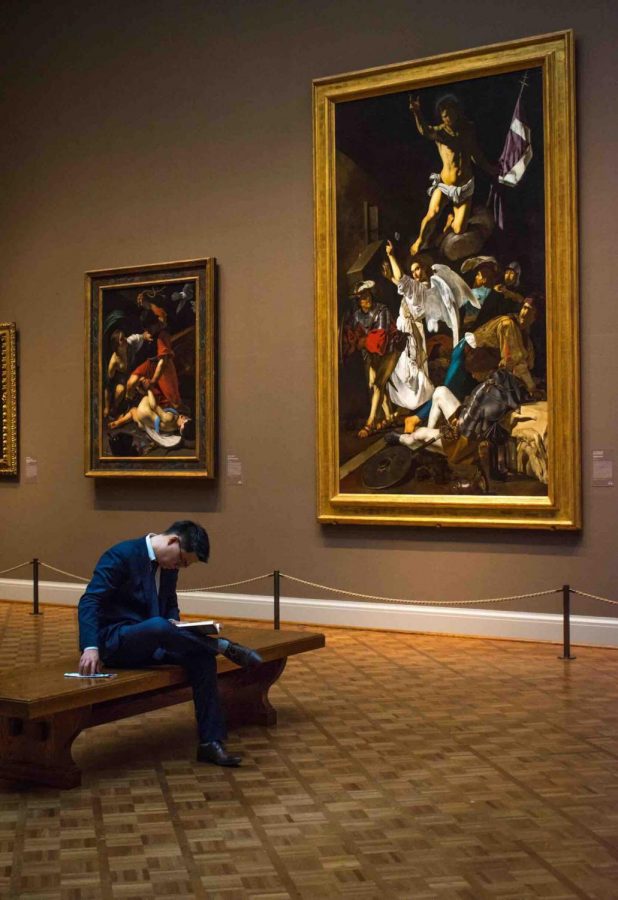Art has great value, especially on a free day
A visitor relaxes in the Art Institute of Chicago.
March 3, 2019
I traveled to the Art Institute of Chicago to talk to Illinois residents about their reasons for attending the museum. Each year many Chicago museums offer free admission days during the slower beginning months and periodically throughout the year.
The Art Institute is free to Illinois residents on Thursday from 5-8 p.m. The Chicago History Museum has free admission for Illinois residents on Tuesdays. The Field Museum offers free admission April 5 -7, May 2 and June 26 -28. The Museum of Contemporary Art has free admission for Illinois residents on Tuesdays.
I was wondering why people would spend the day looking at collections on a recent free day at the Art Institute of Chicago. Why did they attend in a world where Americans barely have the time to finish all their T.V shows, keep up to date with politics, and walk the dog everyday like they promised?
The appreciation and appraisal of art is as varied as the approaches to creating it. And so, I was in the vast white halls of The Institute.
I asked a woman why she was attending, she responded: “If we only focus on our everyday life, probably sometimes dull. We have many routines. If you try to see the world in a different way, you can make the little pieces in life bigger.
“Art is everywhere in life,” she said. “It’s your own eyes looking at that. If you can give art an explanation, that’s not art to me. You can give it a thousand explanations, you cannot say that’s right or wrong.”
Next I spoke to an older woman looking at a film up on the wall. “I’m a member,” she said. “I like coming here. I come here pretty often, I get something different every time. It’s a lot. If you only came here once a year, it’s overwhelming. Every time I come it’s a different experience. You don’t have to be an artist to appreciate art.”
I found a student writing in a notebook. He told me he wouldn’t pay for admittance, but had attended the museum many times with a student card. “People will go to a museum and think, ‘This is good art,’ simply because it’s in a museum. It’s only good art if you think it’s good art. Nothing is right or wrong. Your opinion should not be based on what people who run this institution say you should look at.”
I asked him about the new age accessibility of art, and if because the internet is so close to our fingertips, halls such as these might soon go away or lack importance for young folk. He answered: “The wider access to images of art because of online platforms, in a way, has devalued art. We live in a world where we’re bombarded instantly with images where we’re not truly processing them.”
One man attending on his birthday said: “Here you’re going to find something that tells you something about yourself. You’re going to learn something new, it’s worth it — even if you’re paying for it. When you’re walking out, you’re walking out with a different view than when you came in.”
When I talked to the people in the museum, I wanted to know how they valued art. If they didn’t, why would they spend their day here? If they did, would this place be enough to pay admittance to? Between these positions I hoped to find people who could recognize the significance of art not only to themselves but to the City of Chicago, their community. I found all stances, each of them seemed to recognize sizeable value in the art and their time attending.
Perhaps even to the man who only stopped in because it was free, an understanding of some grasp in value. Art is a tricky trade, and one most Chicagoans are likely never to be involved too much in. I found value in art to the average Chicagoan is hard to measure in that way. No meter stick will do it.
Perhaps silently, factors were trickling in on the city observers. The quiet hall hopefully allows one to let go of the pressure in peer opinions, but might be the greatest opinion of its own. In the white halls near Grant Park it’s hard to think that these items weren’t extremely valuable to at least someone other than their owners. And though the Chicagoans might have walked home with nothing but their fleeting memories of the museum, I daresay they left with free goods. Hopefully, if they were lucky, as if they had stolen something.

